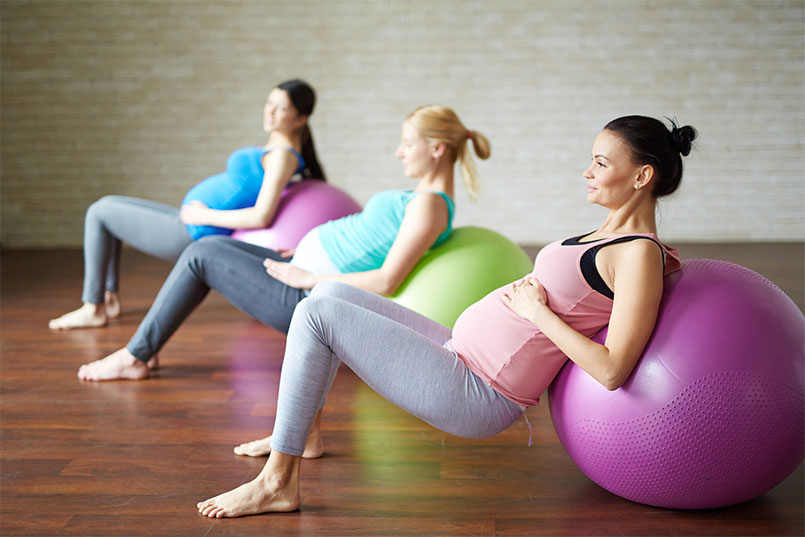Pregnancy is an exciting yet sometimes exhausting and confusing time for expecting mums (and dads).
There is almost too much information out there for us to access yet still a myriad of unanswered questions as it’s hard to know who to listen to or trust.
Let me preface this by saying if you are ever unsure about anything relating to your pregnancy, call your midwife or obstetrician, as they are the experts in the field.
At (almost) 29 weeks pregnant with my second child, and with several friends experiencing their first pregnancy I’ve had a few questions about exercising when pregnant which has prompted me to reflect on the importance and value of staying fit and physically active throughout pregnancy.
Regular appropriate exercise is encouraged as a safe and effective strategy for maintaining good physical and mental health, preparing for childbirth and managing some of the many changes that can occur during pregnancy.
For healthy, uncomplicated pregnancies it is recommended women undertake 30 minutes of moderate intensity (this means you should be puffing but able to talk) exercise on most, if not all, days of the week.
This should include both low-impact aerobic activities (such as walking, swimming, stationary cycling), strength-conditioning exercises (for example Pilates, resistance exercises and yoga) and pelvic floor exercises.
Following these guidelines can have positive physical, mental and emotional benefits, including:
- Improved muscular strength and endurance, cardiovascular function and physical fitness
- Minimising excessive gestational weight gain
- Reduced risk of gestational diabetes and pregnancy-induced hypertension (high blood pressure), especially when combined with a healthy balanced diet
- Reduced musculoskeletal pains and problems, such as back, sacroiliac and pelvic girdle pain
- Reduced fatigue, stress, anxiety and depression
- Prevention and management of urinary incontinence
In no way am I calling myself an expert (after only 1 and ¾ pregnancies), however combining my experience as a physiotherapist, clinical Pilates instructor, mum and pregnant woman, here are some of my helpful tips regarding exercise during pregnancy.
Swimming
I personally love swimming and think it is one of the best forms of aerobic exercise (pregnant or not).
Women with uncomplicated pregnancies can swim throughout their entire pregnancy and it is a great way to get good thoracic rotation, offload the legs and is especially great for ladies struggling through the warmer summer months.
I would generally finish my swim by walking a few laps and doing some gentle resistance exercises (eg: walking forwards, backwards, sidestepping, bum kicks, squats) as the buoyancy of the water unloads your joints but increases the resistance on your muscles.
Having said all this, I love swimming, so it is important you choose a safe form of exercise that you enjoy (e.g. stationary cycling if that’s what floats your boat… weirdo)
Clinical Pilates
With over 5 years experience as a clinical Pilates instructor, I was able to squeeze my own sessions in most days with my first pregnancy and have been doing 2 sessions a week this time around.
Clinical Pilates is a form of supervised exercise that basically retrains the body to work in its most optimal way.
It is a fantastic way of combining muscle strengthening, toning and conditioning with gentle stretching, postural exercises, breathing awareness and pelvic floor activation.
It is generally recommended that after about 16-20 weeks, pregnant women don’t lie flat on their backs (however your body will generally tell you when it’s had enough of this position), therefore adjustments and modifications can easily be made by your instructor to ensure yours and your babies health and safety, whilst still getting a good, individually tailored workout.
Pelvic floor exercises
Outside of my Pilates classes I also did some pelvic floor and transverse abdominal (TA) exercises.
Pelvic floor exercises help to strengthen, increase the endurance and improve the tone of the pelvic floor muscles, which support the pelvic and abdominal structures.
It is recommended that women seek specific advice from a trained physiotherapist about the correct ‘inward and upward’ contraction of the pelvic floor prior to commencing a prescribed program.
Even with my experience as a Pilates instructor, about half way through my pregnancy I had a colleague use real-time ultrasound to re-assess the activation of my pelvic floor and TA so I was sure I was getting the correct activation.
Using the real-time ultrasound enables us to assess the activation of these muscles and correct any poor activation patterns.
Don’t be a hero
This sounds very cliché but listen to your body. If you are feeling to fatigued, swollen or sore give yourself the day off or just do some gentle stretches on the floor (or bed if you’re thinking you won’t ever be able to get off the floor again).
There are some common musculoskeletal issues many pregnant women face including back, pelvic girdle and wrist pain (this pregnancy I have struggled with sacroiliac joint pain which is being managed through manual therapy, exercises and a pregnancy belt).
These are often due to the increased amount of the hormone relaxing in your body but can all be assessed, treated and managed effectively so go see your healthcare professional rather than suffering through months of pain.
I can personally attest to the value of remaining fit and active during pregnancy.
Throughout my first pregnancy (when I was relatively ‘time rich’) I was able to maintain swimming and Pilates daily.
This time around, a combination of an 18-month-old, work and further study commitments have robbed me of my free time and fitness (yes, mum, I know this is no excuse *eyeroll*) and as a result I have been feeling more fatigued, breathless and sore (and have had all these symptoms checked by appropriate health care professionals).
So, don’t let pregnancy scare you away from regular exercise – your body, mind and baby will all thank you for it!

